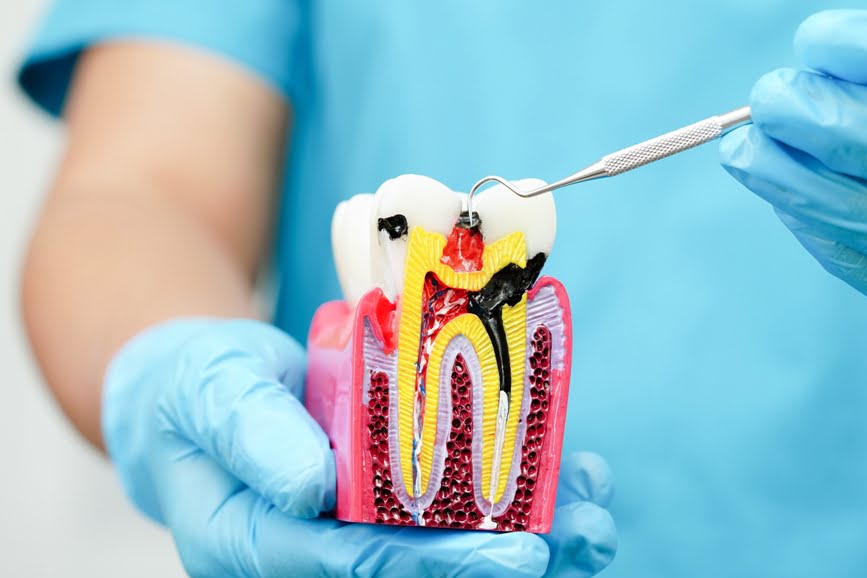
Root canal treatment has long been feared by many due to misconceptions about its pain and discomfort. However, modern dental procedures, advanced technology, and effective anesthesia have made this procedure much more comfortable than many people expect. If you’ve been told you need a tooth root canal treatment, you might be wondering: Is root canal treatment painful? And what exactly can you expect during the root canal treatment procedure? Let’s dive into these questions and set the record straight.
A root canal treatment is a dental procedure used to save a tooth that is severely decayed or infected. When the pulp (the soft tissue inside your tooth) becomes infected due to deep decay, trauma, or cracks, it can cause severe pain. Without treatment, the infection can spread, leading to an abscess, tooth loss, or other serious oral health problems. During a root canal treatment, the infected pulp is removed, and the inside of the tooth is cleaned and sealed.
The most common concern people have when it comes to a root canal treatment is whether it will hurt. The short answer is: No, root canal treatment is generally not painful. In fact, it is performed to alleviate pain caused by infection or decay. Here’s why:
1] Effective Anesthesia: Before the procedure begins, your dentist or endodontist (a specialist in root canals) will numb the area around the affected tooth with local anesthesia. This ensures that you won’t feel pain during the procedure. You may feel some pressure, but the pain is typically well-managed.
2] Advanced Techniques and Tools: Thanks to advancements in dental technology, the root canal treatment procedure has become much more comfortable. Precision tools and modern techniques make the procedure faster, less invasive, and more effective, reducing the likelihood of discomfort.
3] Pain Relief: If you're experiencing significant pain from an infected tooth, the root canal treatment will actually relieve the discomfort. Once the infection is removed, the pain usually subsides, and you'll experience long-term relief.
While some people might feel mild discomfort after the anesthesia wears off, this is usually manageable with over-the-counter pain medications. It’s also common to experience slight soreness or tenderness in the treated area for a few days, especially if the infection was severe. However, this is temporary and typically resolves within a few days.
Understanding what happens during the root canal treatment procedure can help ease any anxiety you might feel. Here are the general root canal treatment steps:
1] Initial Consultation and X-rays: The first step in the process is a thorough examination. Your dentist or endodontist will take X-rays of the affected tooth to determine the extent of the infection or damage. This helps them plan the best course of action for your treatment.
2] Anesthesia: Before the procedure starts, the area around your tooth will be numbed using a local anesthetic. This will ensure that you are completely comfortable and pain-free during the treatment.
3] Access Opening: Once the area is numb, the dentist will create a small opening in the top of the affected tooth to access the pulp chamber. This is done carefully and precisely to avoid unnecessary damage to the tooth.
4] Cleaning the Root Canals: The infected pulp is removed from the inside of the tooth, and the hollow chamber is thoroughly cleaned and shaped. This step is crucial to ensure that all the infection is removed, and the canal is prepared for sealing.
5] Sealing the Tooth: After cleaning, the space inside the tooth is filled with a rubber-like material called gutta-percha. This seals the canals to prevent any further infection.
6] Filling the Tooth: In most cases, a temporary filling is placed to close the access hole. You’ll likely be scheduled for a follow-up appointment to place a permanent filling or crown to restore the tooth’s structure and function.
7] Final Restoration: In some cases, a crown or other permanent restoration may be needed to protect the tooth and restore its functionality. Your dentist will discuss the best options with you.
Throughout the entire process, your dentist will monitor your comfort level and ensure that you’re not experiencing pain. If at any point you do feel discomfort, be sure to let them know so they can adjust the anesthesia.
One of the most common questions patients have is about the recovery process after a root canal treatment. After the procedure, the area may feel tender, especially if there was an infection before the treatment. This is usually short-lived and can be managed with pain relievers. Your dentist may also recommend avoiding chewing hard foods on the treated side for a few days to allow the area to heal.
In most cases, the pain that originally led you to seek a tooth root canal treatment will diminish once the infection is cleared out, and the tooth is sealed. If you experience significant pain or swelling after your procedure, or if the discomfort lasts longer than a few days, it’s important to contact your dentist, as this could indicate a complication.
When it comes to getting the best care for your root canal treatment, it’s important to choose an experienced dentist or endodontist who specializes in this type of procedure. Searching for "the best root canal treatment near me" can help you find highly-rated dental professionals who offer effective treatments using the latest technology.
Look for reviews, ask for recommendations from friends or family, and consider factors like the dentist’s experience, office environment, and comfort level in handling dental anxiety. An experienced professional will make the process as comfortable and efficient as possible.